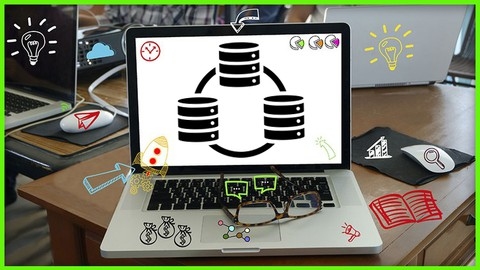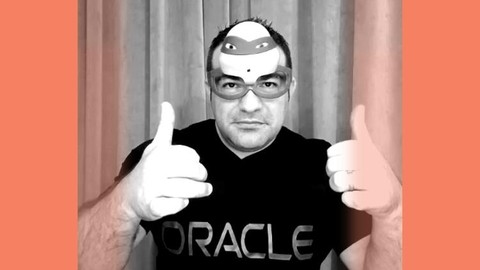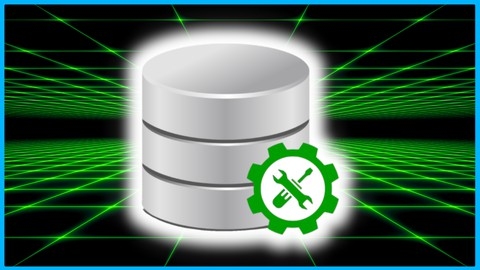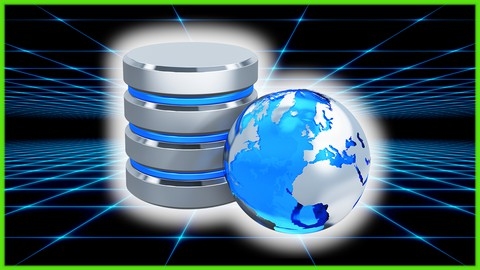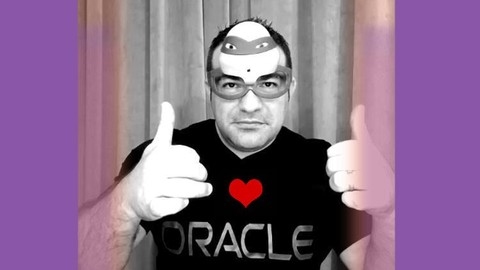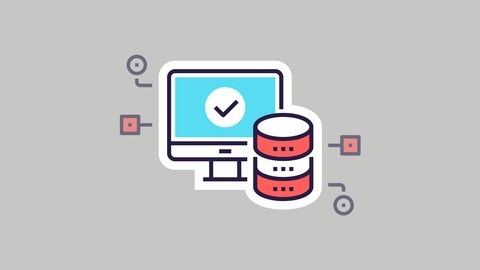The Complete Oracle SQL Certification Course
You’ll start by learning the fundamentals of databases and how SQL is used to interact with them.
The course then dives into single table queries, teaching you how to retrieve data using SELECT statements, filter results with WHERE clauses, and order and format your output.
Next, you’ll explore single row functions (SRFs) like character manipulation, numeric operations, and date formatting.
These allow you to perform calculations and transformations within your queries.
The course also covers grouping functions such as MIN, MAX, AVG, and COUNT, which let you summarize and aggregate data.
As you progress, you’ll learn how to join multiple tables together using various types of JOINs like INNER, OUTER, CROSS, and SELF JOINs.
This is crucial for combining data from related tables.
The course even covers advanced techniques like correlated subqueries and analytic functions with the OVER and PARTITION clauses.
But it doesn’t stop there - you’ll also learn how to create, alter, and update database objects like tables, indexes, and views using SQL DDL and DML statements.
Topics like inserting, updating, and deleting data are covered in-depth.
To prepare you for certification, the course includes additional topics like OFFSET, FETCH, ERD diagrams, transaction control, and working with large objects.
There are even practice tests and exam walkthroughs to ensure you’re ready for the Oracle SQL certification exam.
With dedicated TA support and an online community on Discord, you’ll have access to resources and guidance throughout your learning journey.
The course also provides instructions for installing Oracle Database and SQL Developer on Windows.
The Complete Oracle SQL Bootcamp (2024)
The course starts by introducing you to database concepts, explaining what a database is and why we need them.
You’ll learn about tables, data types, and the relational database model.
The course then dives into retrieving and manipulating data using SQL statements like SELECT, INSERT, UPDATE, and DELETE.
You’ll master techniques like filtering data with WHERE clauses, sorting results, handling NULL values, and using functions for string manipulation, date operations, and more.
One of the course’s strengths is its coverage of advanced SQL topics.
You’ll learn how to join multiple tables using various types of joins, work with subqueries, and combine result sets using set operators like UNION and INTERSECT.
The instructor also explains data definition (DDL) and data manipulation (DML) statements for creating, modifying, and managing database objects.
The course covers Oracle’s powerful features like flashback technologies for querying historical data, constraints for enforcing data integrity, views for presenting customized data perspectives, and indexes for optimizing query performance.
You’ll also learn how to manage privileges and roles, a crucial aspect of database security.
Throughout the course, you’ll work with hands-on examples and coding exercises to reinforce your learning.
The instructor’s explanations are clear and concise, making complex concepts easy to understand.
The course materials include code samples, cheat sheets, and certification exam samples, providing valuable resources for your SQL journey.
The Complete PL/SQL Bootcamp : Beginner to Advanced PL/SQL
The course starts by introducing you to PL/SQL, explaining what it is and why you should use it.
You’ll learn about the PL/SQL architecture, pluggable databases, and the sample HR schema used throughout the course.
After covering the basics, you’ll dive into software installation, with multiple options provided, including using a virtual machine, installing Oracle Database on your computer, or using Oracle Live SQL.
Once you have your development environment set up, the real fun begins!
You’ll learn how to write your first PL/SQL code, work with variables, control structures (loops, if statements, etc.), and use SQL within PL/SQL.
The course then covers composite data types like records, collections (varrays, nested tables, associative arrays), and how to store them in tables.
One of the most important topics covered is PL/SQL cursors, which allow you to work with bulk data row by row.
You’ll learn about explicit cursors, cursor parameters, cursor attributes, and more.
The course also teaches you how to handle exceptions, both predefined and user-defined, using various techniques.
Moving on, you’ll learn how to create and use PL/SQL functions and procedures, including local subprograms, overloading, and exception handling within subprograms.
The course then dives into PL/SQL packages, covering their creation, usage, modification, and removal, as well as package initialization and persistent state.
Another crucial topic is PL/SQL triggers, where you’ll learn about different trigger types (DML, statement-level, row-level), timing, conditional predicates, and more.
You’ll also learn how to debug your PL/SQL code using the PL/SQL debugger.
The course covers dynamic SQL and PL/SQL, teaching you how to create and use them with various techniques like EXECUTE IMMEDIATE, OPEN-FOR, and the DBMS_SQL package.
Additionally, you’ll learn about Oracle-supplied packages like DBMS_OUTPUT, UTL_FILE, and UTL_MAIL, which can be incredibly useful in your PL/SQL development.
Throughout the course, you’ll find quizzes to test your knowledge and reinforce the concepts you’ve learned.
The course also includes supplementary resources, such as instructions for installing Oracle Database and configuring SQL Developer.
Oracle Database 12c SQL Certified Associate 1Z0-071
The course starts with an introduction to database concepts like tables, data models, primary and foreign keys, and the system development life cycle.
You’ll learn about the Oracle 12c architecture and get hands-on experience connecting to the database using tools like SQL Plus and SQL Developer.
From there, you’ll dive into the core SQL statements for querying data with SELECT, restricting results with WHERE, sorting with ORDER BY, and more.
The syllabus covers single-row functions for formatting output, conversion functions, conditional expressions like CASE and DECODE, and aggregate functions like SUM and COUNT.
An important part of the course focuses on joining data from multiple tables using various types of joins, from the older equi/non-equi syntax to the modern ANSI 1999 syntax with INNER, OUTER, CROSS joins etc.
You’ll also learn how to use subqueries and set operators like UNION effectively.
The syllabus then moves into data manipulation with INSERT, UPDATE, DELETE statements and transaction control with COMMIT, ROLLBACK.
You’ll learn DDL for creating/altering tables and constraints.
Other key topics include sequences, indexes, views, access control, and data warehousing concepts.
The course wraps up with some advanced topics like intervals, timestamp data types for working with different time zones, and using dynamic SQL.
There are sections dedicated to the certification exam 1Z0-071 and recommendations for further learning PL/SQL.
Oracle SQL Performance Tuning Masterclass (2024)
This course covers all the essential topics you need to master SQL performance tuning on the Oracle database.
Right from the start, you’ll learn the fundamentals of SQL tuning - what it is, when to do it, and the basics of how an SQL statement gets processed by the Oracle optimizer.
The course dives deep into the Oracle database architecture, explaining critical components like the buffer cache, shared pool, and PGA in detail.
Understanding these is key for effective tuning.
You’ll gain expertise in reading and analyzing execution plans, a vital skill for identifying performance bottlenecks.
The course methodically covers all the table and index access paths used by Oracle, join methods like nested loops and hash joins, as well as other optimizer operations like filters and sorts.
Having this knowledge allows you to interpret execution plans accurately.
Importantly, you’ll learn a wide range of SQL tuning techniques through hands-on examples.
From basic tips like avoiding unnecessary columns to advanced methods like using bind variables and cursor sharing.
The course even covers indexing strategies like bitmap indexes, index-organized tables, and how to combine indexes effectively.
The syllabus includes advanced topics like tuning star queries, using adaptive plans, and dynamic statistics sampling - techniques that can provide significant performance gains.
You’ll also learn how to leverage tools like SQL monitoring and tracing for analysis.
What’s great is that the course lets you choose between installing a virtual machine image with an Oracle database or doing a local installation.
So you can follow along with a setup suited to your needs.
The lectures seem very detailed yet easy to understand, often providing code samples.
Oracle SQL Developer: Mastering its Features + Tips & Tricks
This course takes you on a comprehensive journey through Oracle SQL Developer, a powerful tool for working with Oracle databases.
You’ll start by learning how to install the program on your Windows machine.
While having an Oracle database already set up is a prerequisite, the course includes a bonus lecture that guides you through installing Oracle Database Express Edition 18c on Windows, just in case you need it.
Once you have SQL Developer up and running, the course dives into the basics, covering the user interface, creating database connections, working with worksheets, and navigating result grids.
This lays the foundation for more advanced topics.
Customization is a key focus area, with several lectures dedicated to tailoring SQL Developer to your preferences.
You’ll learn how to change the language, disable unnecessary features, improve data display, format code, filter navigation, and even customize fonts and syntax colors for better readability.
Reports are another major component, covering predefined reports, user-defined reports, master-detail and drill-down reports, gauges, charts, exporting, and sharing.
You’ll gain insights into designing and modifying various report types effectively.
But the course doesn’t stop there!
It delves into a wide range of useful features, tips, and tricks to boost your productivity.
From splitting worksheets and exporting data to code templates, snippets, and smart testing/debugging, you’ll discover numerous ways to streamline your workflow.
Additionally, you’ll explore techniques for finding database objects, generating relational diagrams, navigating code, performance tuning, and even displaying gauges within SQL Developer.
Interestingly, the course also touches on using HTML in SQL and preferences, a lesser-known but handy feature.
And as a bonus, you’ll get access to additional content and discounts for other courses taught by the instructor.
Oracle PL/SQL Fundamentals vol. I & II
The course begins by introducing you to PL/SQL, its blocks, and how to work with SQL Plus.
You’ll learn about declaring various data types, including simple types like CHAR and NUMBER, as well as complex types like records and collections.
The syllabus dives into working with variables, operators, SQL functions, and embedding SQL statements within PL/SQL.
You’ll gain an understanding of logic control structures like loops, conditional statements, and exception handling.
The course covers explicit cursors in depth, teaching you about cursor attributes, parameters, and different types of cursors like updateable and FOR-LOOP cursors.
Moving on, you’ll explore database program units such as stored procedures, functions, and packages.
You’ll learn how to create, execute, and manage dependencies for these units.
The syllabus also covers advanced techniques like persistent global objects and object-oriented support within packages.
The course introduces you to cursor variables, including weak cursor definitions and REF CURSORs.
You’ll work with built-in packages like DBMS_OUTPUT and UTL_FILE for output and file handling.
Database triggers are a key topic, covering statement-level, row-level, and INSTEAD OF triggers.
You’ll learn how to use triggers within applications, handle mutating table issues, and work with compound and system event triggers.
Throughout the course, you’ll have access to additional resources and example files provided by the instructor to reinforce your learning.
The Ultimate Oracle SQL Course: SQL Made Practical
The course starts by introducing you to SQL and database fundamentals, ensuring you have a solid grasp of the basics before diving into practical examples.
You’ll learn how to set up your environment, whether you prefer to install Oracle Database locally or work entirely within your browser.
Once the groundwork is laid, you’ll explore the core of SQL - retrieving data using SELECT statements.
The course guides you through filtering, sorting, handling nulls, and using operators like LIKE, IN, and BETWEEN.
You’ll also learn how to combine rows using set operators (UNION, INTERSECT, MINUS).
The syllabus dives deep into crucial SQL concepts like subqueries, analytic functions (ranking, windowing, lead/lag), and hierarchical queries.
These advanced topics are often overlooked in other courses but are essential for real-world applications.
The course doesn’t stop there - it covers data manipulation (INSERT, UPDATE, DELETE, MERGE) and data definition (creating/altering tables, constraints, indexes, views).
You’ll even learn how to control user access through privileges and roles.
Throughout the course, you’ll work on numerous practice challenges and coding exercises, solidifying your understanding of each topic.
The instructor provides solutions, ensuring you grasp the concepts thoroughly.
Oracle PL/SQL is My Game: EXAM 1Z0-149
You’ll start by setting up the necessary environment, including installing Oracle Database or using the provided HR schema.
The course covers the fundamentals of PL/SQL, such as its structure, blocks, and variables.
You’ll learn how to declare variables, work with different data types, and use delimiters for string literals.
As you progress, you’ll dive into writing executable statements, interacting with the Oracle database server using SQL and DML statements, and understanding implicit SQL cursors.
The course also covers control structures like IF statements, loops, and CASE expressions, which are essential for writing efficient PL/SQL code.
You’ll explore composite data types like records, associative arrays, nested tables, and varrays, enabling you to work with complex data structures.
The course delves into explicit cursors, a powerful tool for querying and manipulating data, and exception handling, crucial for robust error management.
The curriculum covers creating procedures, functions, and packages, which are building blocks for modularizing and organizing your PL/SQL code.
You’ll learn about overloading subprograms, persistent state, and using Oracle-supplied packages like DBMS_OUTPUT and UTL_FILE for application development.
Dynamic SQL, a technique for constructing and executing SQL statements at runtime, is also covered, along with design considerations like standardization, rights, autonomous transactions, and performance optimization hints.
The course explores triggers, including statement-level, row-level, compound, DDL, and event database triggers, enabling you to enforce business rules and maintain data integrity.
You’ll also learn about the PL/SQL compiler, managing code dependencies, and using tools like conditional compilation and obfuscation.
Oracle SQL - Step by Step SQL
The syllabus covers a comprehensive range of topics, starting with the basics of installing Oracle and SQL Developer.
You’ll learn fundamental database concepts like tables, transactions, and ACID properties before diving into SQL.
The course takes you step-by-step through SQL queries, teaching you how to retrieve, filter, sort, and combine data from multiple tables using various operators and joins.
You’ll also learn to summarize data using aggregate functions and the GROUP BY clause.
Importantly, the syllabus includes hands-on lab exercises with answers for each major topic, allowing you to practice what you’ve learned.
This practical approach can help reinforce your understanding of SQL.
Beyond querying, the course covers data manipulation (INSERT, UPDATE, DELETE) and definition (CREATE, ALTER, DROP) using DML and DDL statements.
You’ll learn about constraints like PRIMARY KEY, FOREIGN KEY, and CHECK to maintain data integrity.
The syllabus also touches on advanced topics like views, sequences, subqueries, indexes, and granting/revoking permissions.
A final recap section ties everything together with a 5-step process for solving business problems using SQL.


